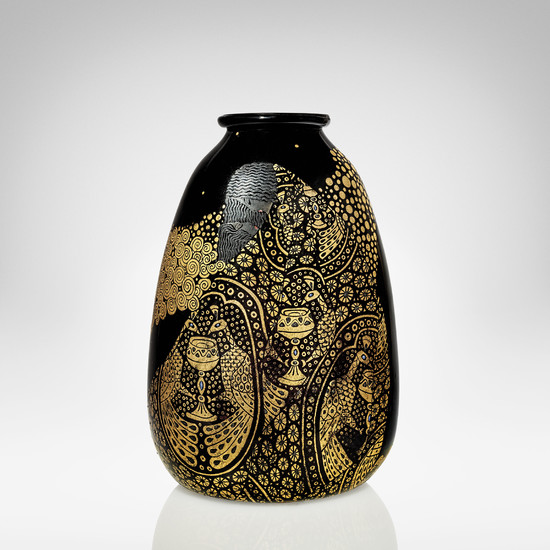VITTORIO ZECCHIN (1878-1947), THE 'SALOMÉ' VASE, 1921
VITTORIO ZECCHIN (1878-1947)
The 'Salomé' vase, 1921
amethyst glass, applied gold leaf decoration with blue, red and black enamel details in relief
applied decoration by Vittorio Gazzagon
14 3/8 in. high (36 cm.)
with enamel artist's cypher VZ
Pre-Lot Text
The vase is of classic shape, ovoid and tapered at the mouth with a defined and narrow border.
In the decoration, the figure of Salomé stands out on an indistinct background holding the severed head of Saint John the Baptist. The Gospel narrates that Herod had had the Saint arrested for openly criticising his union with Herodias, already his brother's wife, but had not had the courage to order his death. During a banquet, Salomé performed a sensual dance and a mesmerised Herod promised he would grant her any wish; the girl, compelled by her mother Herodias, then asked to have the head of John the Baptist on a tray.
This theme was very dear to the artist and was a recurrent subject of his drawings, oils, tapestries and decorative arts. The lower part of the vase was decorated with repeated medallions enclosing two peacocks drinking from a chalice. The peacocks, sacred animals to Juno for their role in accompanying the souls of the empresses to the afterlife are a symbol, in Christian doctrine, of royalty, beauty and immortality.
Symbolism and historicism come together in this extraordinary vase. The author was certainly seduced by the same aesthetics that animated Klimt's exhibition at the 1910 Venice Biennale and for the design of this vase, was unconventionally inspired by Medieval and Lombard culture. The decoration can be compared to the motif found on a Cipollino marble pluteus dating from the beginning of the 8th century, from the oratory of San Michele alla Pusterla and currently part of the collection of the Malaspina Civic Museum, Pavia; a testimony to the Lombardic sculptural tradition, in a frame formed by twenty-six roundels depicting symbols of both flora and fauna, two peacocks facing each other, drinking from a cup, from which a Christian cross emerges.
The work vase was exhibited at the Fiorentina Primaverile exhibition in 1922 (illustrated) however the theme of the Salomé was, as early as in 1919, the main subject of a tapestry, as part of the solo exhibition by Vittorio Zecchin held at the Bevilacqua La Masa Opera in Venice, at which twenty-four works by the artist and designer were displayed, including embroidered tapestries, chalices and glass vases.
Maria Paola Maino
PROPERTY FROM AN IMPORTANT PRIVATE EUROPEAN COLLECTION
View it on
Sale price
Estimate
Time, Location
Auction House
VITTORIO ZECCHIN (1878-1947)
The 'Salomé' vase, 1921
amethyst glass, applied gold leaf decoration with blue, red and black enamel details in relief
applied decoration by Vittorio Gazzagon
14 3/8 in. high (36 cm.)
with enamel artist's cypher VZ
Pre-Lot Text
The vase is of classic shape, ovoid and tapered at the mouth with a defined and narrow border.
In the decoration, the figure of Salomé stands out on an indistinct background holding the severed head of Saint John the Baptist. The Gospel narrates that Herod had had the Saint arrested for openly criticising his union with Herodias, already his brother's wife, but had not had the courage to order his death. During a banquet, Salomé performed a sensual dance and a mesmerised Herod promised he would grant her any wish; the girl, compelled by her mother Herodias, then asked to have the head of John the Baptist on a tray.
This theme was very dear to the artist and was a recurrent subject of his drawings, oils, tapestries and decorative arts. The lower part of the vase was decorated with repeated medallions enclosing two peacocks drinking from a chalice. The peacocks, sacred animals to Juno for their role in accompanying the souls of the empresses to the afterlife are a symbol, in Christian doctrine, of royalty, beauty and immortality.
Symbolism and historicism come together in this extraordinary vase. The author was certainly seduced by the same aesthetics that animated Klimt's exhibition at the 1910 Venice Biennale and for the design of this vase, was unconventionally inspired by Medieval and Lombard culture. The decoration can be compared to the motif found on a Cipollino marble pluteus dating from the beginning of the 8th century, from the oratory of San Michele alla Pusterla and currently part of the collection of the Malaspina Civic Museum, Pavia; a testimony to the Lombardic sculptural tradition, in a frame formed by twenty-six roundels depicting symbols of both flora and fauna, two peacocks facing each other, drinking from a cup, from which a Christian cross emerges.
The work vase was exhibited at the Fiorentina Primaverile exhibition in 1922 (illustrated) however the theme of the Salomé was, as early as in 1919, the main subject of a tapestry, as part of the solo exhibition by Vittorio Zecchin held at the Bevilacqua La Masa Opera in Venice, at which twenty-four works by the artist and designer were displayed, including embroidered tapestries, chalices and glass vases.
Maria Paola Maino
PROPERTY FROM AN IMPORTANT PRIVATE EUROPEAN COLLECTION



